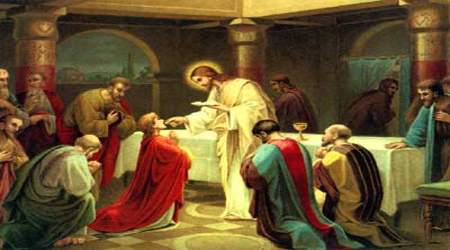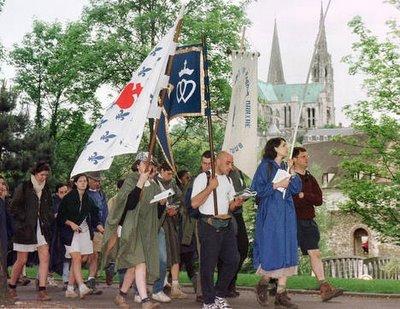
The law of prayer is the law of belief. In other words, how you pray determines what you believe.
The "reformers" of the Protestant Reformation (more aptly called revolutionaries) set as their primary goal the destruction of the Holy Sacrifice of the Mass. That is, after all, the foundation and keystone of the Catholic faith; it is the base on which the entire edifice stands; it is the keystone with which the giant structure is crowned. It is the Holy Sacrifice, offered on hundreds upon thousands of altars everywhere in atonement for the sins of mankind, that holds back the wrath of God and makes way for His mercy. The Holy Sacrifice is the One True Thing in our Catholic faith. It is, in fact,
everything, because it re-presents the one historical Act that alone has opened up the gates of Heaven, and bears aloft the whole teeming uncertain world. All else--evangelization, teaching, serving the needy--is tangential to and only made possible by that Oblation repeated on Catholic altars all over the globe.
Suffice it to say that the highest form of prayer is the Mass. There is no prayer higher. There is no act, no sacrifice, no worship, that can please God more than the offering of Christ on the high altar.
It follows, then, that it is worth doing properly.
Lex orandi, lex credendi. Therefore, next time you wonder why we care so much about the liturgy, you'll know. Next time you wonder why the "externals" matter so much, you'll understand. Next time you ask why we're so "obsessed" about "inessentials," you will comprehend.
John Zmirak put it well:
From now on, to get a movie ticket, Americans should have to kneel before a consecrated celibate wearing ceremonial robes and take the ticket between their teeth – never daring to touch it with their hands. Within a generation or so, they’d all develop certain ideas about movie tickets and their significance.
Now take the Eucharist and reverse the process, treating it like a movie ticket…Enough said.
Is it really any wonder only 30% of Catholics today believe in the Real Presence of Jesus in the Eucharist?
Lex orandi, lex credendi.I know of well-intentioned, orthodox Catholics who don't get what all the fuss is about concerning Mass in the Extraordinary Form, being perfectly content to accept the Novus Ordo as what "Holy Mother Church has given us." A little digging only reveals that the Novus Ordo Mass in its present form is NOT at all in keeping with what the Vatican II documents envisioned, nor what Pope Paul VI himself had hoped for when he approved the New Mass. These are not the accusations of some deranged traditionalist; read the Liturgy Constitution for yourself, and you will see that: Latin was supposed to be preserved; the faithful were to be taught how to say the Latin responses; sacred music was to be retained and encouraged; and Gregorian chant was to be given pride of place in the liturgy. How many of these Vatican II directives have modern parishes--who claim to be faithful to this Council--followed? Rather, is it not more common to hear Protestant execrations like "Breathe" or "All Are Welcome" (and often blared loudly post-Communion, interrupting one's intimate moments with Our Lord)?

Communion in the hand--the norm in 99% of all Novus Ordo parishes--is a corruption introduced by disobedient clergy who eventually got their way. It never surprises me to find a correlation between the numbers of parishioners who receive on the tongue and the number who genuflect before the Tabernacle; the latter usually diminishes in inverse proportion to the former.
As to altar girls, that was also a corruption introduced by disobedient bishops who probably thought it might pave the way for female ordination. Although they haven't gotten female ordination--
Deo gratias--they've gotten their female altar servers, taking up the places that rightfully belong to male youths who may be called to a vocation.
One of the most tragic aspects of the implementation of the New Mass, however, was one that Pope Paul VI never foresaw: the wholesale destruction of so many venerable high altars in Catholic Churches everywhere, in order to make way for freestanding blocks of stone where the priest could face away from the East--always traditionally the direction of the rising sun, symbolic of our Lord's Resurrection, and therefore sacrificial in emphasis--toward the people, with the focus now on a communal feast at the table of the Lord's Supper. The only other time in history that so many high altars were smashed was during the Reformation.

I remember this fact hitting home to me rather vividly when I made a pilgrimage to the Basilica of Lisieux, built in honor of St. Thérèse. Essentially completed in the 1930s, the vast church is flanked by numerous side chapels, each one--as was proper to the time--with an altar attached to the wall. After the so-called "mandate" to face the people (the mandate never existed), every single one of these altars was rendered obsolete. Now they stood as mere historical remnants, carved stone slabs ringing the nave where once stood priests offering the sacrifice, today empty. There was something heartbreaking about the whole thing--and the same holds true in all the old churches in Europe and elsewhere. These ancient churches are a testament to the drastic measures taken by the pseudo-liturgists in the 1960s and beyond, not because they've been renovated, but because they have
not.
This is in no way to detract from holy, faithful priests who reverently offer the Novus Ordo and foster true devotion to the Blessed Sacrament. May God bless them richly. But what a wonder the Motu Proprio has been, opening the way to Mass in the Extraordinary Form everywhere, bringing back the ancient and beautiful liturgy, where the whispered prayers underscore the sacred and awful mysteries taking place on the altar, the words leaving no doubt of the sacrificial nature of Mass; where the music directs the mind and heart upward to God, rather than downward to self; and where the priest, along with all the people, face the Lord in the Tabernacle, who is the Source of all life, deserving of all glory, honor, and love.
 Mgr Vingt-Trois, archbishop of Paris, makes a significant gesture of welcome to traditionalists (from La Lettre de Paix Liturgique):
Mgr Vingt-Trois, archbishop of Paris, makes a significant gesture of welcome to traditionalists (from La Lettre de Paix Liturgique):
 The law of prayer is the law of belief. In other words, how you pray determines what you believe.
The law of prayer is the law of belief. In other words, how you pray determines what you believe.  Communion in the hand--the norm in 99% of all Novus Ordo parishes--is a corruption introduced by disobedient clergy who eventually got their way. It never surprises me to find a correlation between the numbers of parishioners who receive on the tongue and the number who genuflect before the Tabernacle; the latter usually diminishes in inverse proportion to the former.
Communion in the hand--the norm in 99% of all Novus Ordo parishes--is a corruption introduced by disobedient clergy who eventually got their way. It never surprises me to find a correlation between the numbers of parishioners who receive on the tongue and the number who genuflect before the Tabernacle; the latter usually diminishes in inverse proportion to the former.  I remember this fact hitting home to me rather vividly when I made a pilgrimage to the Basilica of Lisieux, built in honor of St. Thérèse. Essentially completed in the 1930s, the vast church is flanked by numerous side chapels, each one--as was proper to the time--with an altar attached to the wall. After the so-called "mandate" to face the people (the mandate never existed), every single one of these altars was rendered obsolete. Now they stood as mere historical remnants, carved stone slabs ringing the nave where once stood priests offering the sacrifice, today empty. There was something heartbreaking about the whole thing--and the same holds true in all the old churches in Europe and elsewhere. These ancient churches are a testament to the drastic measures taken by the pseudo-liturgists in the 1960s and beyond, not because they've been renovated, but because they have not.
I remember this fact hitting home to me rather vividly when I made a pilgrimage to the Basilica of Lisieux, built in honor of St. Thérèse. Essentially completed in the 1930s, the vast church is flanked by numerous side chapels, each one--as was proper to the time--with an altar attached to the wall. After the so-called "mandate" to face the people (the mandate never existed), every single one of these altars was rendered obsolete. Now they stood as mere historical remnants, carved stone slabs ringing the nave where once stood priests offering the sacrifice, today empty. There was something heartbreaking about the whole thing--and the same holds true in all the old churches in Europe and elsewhere. These ancient churches are a testament to the drastic measures taken by the pseudo-liturgists in the 1960s and beyond, not because they've been renovated, but because they have not. Lapsed Catholic Heidi Ewing and her friend Rachel Grady, two filmmakers made famous by their documentary
Lapsed Catholic Heidi Ewing and her friend Rachel Grady, two filmmakers made famous by their documentary  Reading
Reading 


